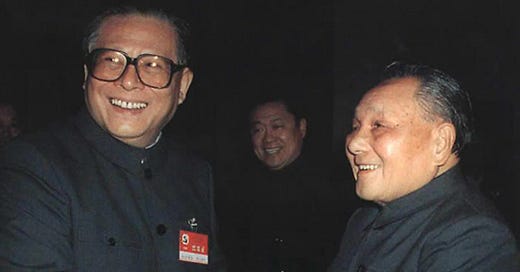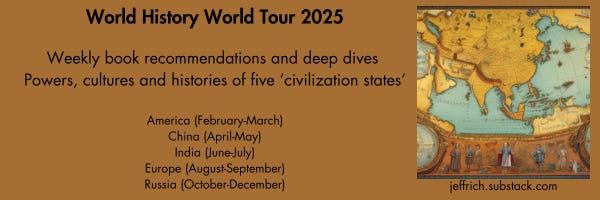China's Great Transformation 1976 to 2012
Week Seven of the Deep Dive into China as a Modern Civilization-State
On 4 June 1989 events occurred in Tiananmen Square that changed China’s trajectory as a world power. Coincidentally my piece on China’s Great Transformation 1976 to 2012 is being published on the anniversary of those events. Tiananmen Square changed the trajectory of China’s transformation, but did not define it alone.
Welcome to the seventh instalment of my eight-week deep dive into China as a modern civilization-state. This deep dive guides you through one leading scholarly history—Klaus Mühlhahn, Making China Modern: From the Great Qing to Xi Jinping—as part of my World History World Tour 2025.
The seventh instalment looks at China's Great Transformation between 1976 and 2012. Led initially by Deng Xiaoping, China returned to the four old paths of modernisation after the ten years of chaotic revolution. China’s choice coincided with other historic transformations. Container shipping, communications, cheap flights, financial technologies, wealth, ageing, education, open markets, and globalised networks transformed the forces of world society. In rapid succession, the Berlin Wall fell in 1989, the Soviet Union dissolved in 1991, and India began its own path of halting market liberalisation. New globally accessible markets created vast opportunities for China. It transformed in a few decades from poor ideologically obsessed revolutionary state to the industrial colossus that displaced America’s command of the world. Two of the most important historical questions today are: how did this transformation occur, and what were its consequences?
Mühlhahn organises his narrative of this period into two phases. Reform and Opening 1977-1989 narrates the birth of the “China Model” under Deng Xiaoping. Overall Advance 1990-2012 describes the era of the China Model’s “super-high growth” until the start of the Presidency of Xi Jinping. The dramatic caesura of Tiananmen Square in 1989 defines the arc of this narrative, as it does in so many historical and political interpretations of modern China. Mühlhahn writes:
Instead of simply representing a setback for reform, Tiananmen and 1989 permanently altered China’s reform trajectory. From then on, economic reform accelerated and expanded, based on centralization and the availability of inexpensive migrant labour. At the same time, stability and security became overruling prerogatives in political, cultural and social life. The basic issues and concerns raised by the 1989 social movement, such as democracy, liberty and equal opportunities, were shunted aside. A new, authoritarian, yet self-confident China emerged. Amid the bloody chaos in Tiananmen Square and the transformations in the world of 1989, the China Model was born.
(Mühlhahn, Making China Modern, p. 448)
I am suspicious of historical narratives grounded on the concept of “authoritarian.” It has been a tool of Western Cold War thinking since its inception in the early 1950s, however much we may esteem a rare few of its practitioners, such as Hannah Arendt. The concept is used variously to describe the absence of elections, deviation from Western political institutions, arbitrary use of government power outside the constraints of the rule of law, unquestioning obedience to authority, illiberalism, or the ‘authoritarian personality,’ conceived in the early 1950s to explain fascism and to slur socialism in both China and the Soviet Union. At times, the term means little more than states that spurn the West. Western ideologists have devalued its currency by promiscuous use in the rhetoric of the First and Second Cold Wars.
But Mühlhahn’s argument is subtler than the likes of Anne Applebaum, with her Autocracy, Inc.: The Dictators Who Want to Run the World. Making China Modern describes the emergence of complex institutions from domestic and international forces. Those institutions need to be understood in their own terms, rather than through a convex mirror of Western intellectual design. China was never going to become a “Western liberal democracy.” China’s history since 1644, which we have been learning through Mühlhahn’s Making China Modern, has charted a different path. Nor is China repeating the Soviet history of 1917 to 1989, the fascist European path of 1920 to 1945, or the “totalitarian” nightmare of American Atlantic scholars and intelligence services since the 1950s. All the domestic and external events that shaped the institutions of Chinese state and society came together in a unique way after the catastrophic trauma of the Cultural Revolution. Mühlhahn writes,
“The results are new hybrid institutional settings that combine public and private actors in ways that defy Western patterns and models, and that are difficult to analyze with any precision.”
(Mühlhahn, Making China Modern, p. 490)
If it is difficult for this renowned scholar, who spent ten years writing his book, to interpret China’s Great Transformation, then I would not doubt that there are limitations to his work; nor would this novice dare to defy his balanced conclusions. Compared to many historians, who wear their geopolitical colours on their sleeves, Mühlhahn’s book allows the reader to ask fertile questions. He opens questions better than a melancholy lament, such as “Why did China turn its back on Western, democratic political reform?”—whether that turning point is seen as Tiananmen Square in 1989 or Xi Jinping’s Presidency in 2012. Rather, he asks how state and society walked China’s path through world history.
“Institutional innovation and rapid economic growth also brought about a profound and unprecedented social transformation of Chinese society, reconfiguring its social structure and redistributing power between state and society.”
(Mühlhahn, Making China Modern, p. 489)
Symbolically, China’s era of reform and opening did not begin with an emulation of the West, or a yearning to be like America, notwithstanding the photo-op when Deng Xiaoping donned a cowboy hat to please his hosts. It began with the reestablishment in 1977 of the entrance examination system, the gaokao. This old institution that Mao had sought to smash was Deng Xiaoping’s path to modernisation.
“This reintroduction has to be seen as one of the most dramatic and important decisions made at the outset of China’s era of reform and opening… In the content of a focus on institutions, it is also important to note that this was not based on transfers from the West. Rather, it revived a centuries-old Chinese institution.”
(Mühlhahn, Making China Modern, p. 488)
This unique Chinese story unfolded and was closely linked to international developments. “Under Deng Xiaoping,” Mühlhahn writes, “Chinese society consistently capitalized on the opportunities generated by a changing world.” Did his successors, in the years after Tiananmen, perform their role of helmsmen as well?
The story of China’s Reform and Opening (1977-1989) and Overall Advance (1990-2012) are below the line.
Please become a paid subscriber to get more of my insights, book recommendations and deep dives into how history can reveal the hidden patterns of our changing world.




